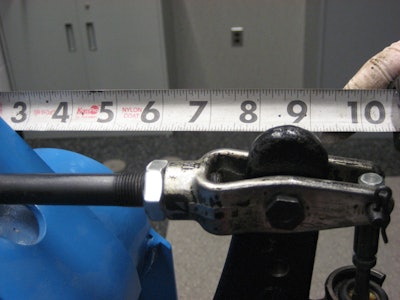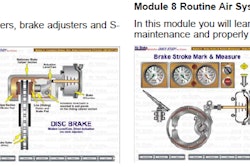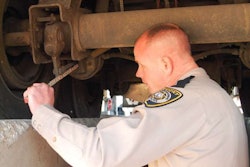 If an automatic slack adjuster’s stroke is too long, it takes away from the brake’s force.
If an automatic slack adjuster’s stroke is too long, it takes away from the brake’s force.Automatic brake adjusters don’t need a lot of attention, but they certainly don’t fall in the set-it-and-forget-it category. Periodic inspection and lubrication are critical to optimal performance.
When the brake is applied, a rod pushes out on the slack adjuster, which then turns the S-cam to force the brake shoes apart to apply friction. The automatic slack adjuster (ASA) is designed to compensate for wear in the brake lining and brake drum to maintain a constant stroke of the actuator. Inadequate stroke can diminish braking power.
“Dimensions and the geometry have to be maintained throughout the life of the pad in order to keep the performance and efficiency of the brake up,” says Joe Kay, director of brake engineering for Meritor. “That’s where the automatic slack adjuster comes into play.”
LUBE REGULARLY. ASAs often are not greased regularly during scheduled maintenance and inspections, says Keith McComsey, director of marketing and customer solutions for wheel ends at Bendix Spicer Foundation Brake.
“Slack adjusters that don’t perform properly through lack of lubrication can have a direct impact on both safety and regulatory compliance,” he says.
Properly lubricating the ASA purges the old grease, water and any contaminants from the adjuster and protects its internal components from wear.
McComsey says lubrication with an NGLI grade-2 lubricant at least every 30,000 miles should take less than a minute per adjuster, “but you can also make things less complicated by greasing the ASAs every time you do a preventive maintenance inspection.”
Mitch Forbes, senior technical service representative for Haldex, recommends at least an annual lubrication interval with a standard chassis grease applied by hand. He discourages the use of moly-disulfide grease on Haldex slack adjusters, as it can affect the function of the internal friction clutches and reduce the reliability of automatic adjustments.
MAKE ROUTINE INSPECTIONS. Visual inspections and operational checks, including brackets and control arms, should be performed at each preventive maintenance service interval. Forbes says adjusters or anchor brackets that have visual damage or fail operational checks should be replaced immediately.
As part of pre- and post-trip inspections, drivers should inspect the slack adjuster for correct operation, lose or missing hardware, missing cotter pins, worn clevises – including the clevis pins and clevis pin bushings – and bent or damaged components such as the control arm and attaching anchor brackets.
A truck that runs lightly loaded is more susceptible to vibration, which Kay says can accelerate brake stroke issues. “You want to make sure the clevis pins are inspected, because the more vibration they get, the more wear they get,” he says. “Pins wearing inside the holes can add extra clearances, and those extra clearances can add up to extra stroke when applying the brake.”
McComsey also recommends checking the brake shoe return springs to ensure a proper return to the zero-stroke position.
“If the stroke is too long, the brake chamber would essentially go to its maximum length, and the force of the brake drops,” Kay says. Stroke “is one of the first things that would indicate that something’s not right with this particular brake.”
Kay says in typical line-haul applications, assuming basic maintenance, it’s common for ASAs to last the life of the truck. However, an application that requires more starting and stopping would warrant ASA replacement at some point, “because every component on the brake is going through a fatigue cycle,” he says.
AVOID MANUAL ADJUSTMENT. “The only times that an automatic brake adjuster needs to be adjusted is during a foundation brake repair or initial set-up,” Forbes says. “Manually adjusting a brake adjuster causes premature wear on internal components and leads to the adjuster becoming inoperable.”
McComsey says there are many reasons an ASA may fall out of adjustment, but it is unlikely that a manual adjustment will correct the problem.
“Manual adjustment may seem to temporarily solve the out-of-adjustment issue, but there may be other factors at play that must be addressed,” he says. “Otherwise, the condition will reoccur.”
“A thorough inspection of the brake system is needed to determine the root cause,” Forbes adds.










